The developmental remodeling of eye-specific afferents in the ferret dorsal lateral geniculate nucleus
- PMID: 20039439
- PMCID: PMC2923217
- DOI: 10.1002/ar.21001
The developmental remodeling of eye-specific afferents in the ferret dorsal lateral geniculate nucleus
Abstract
Eye-specific projections to the dorsal lateral geniculate nucleus (dLGN) serve as a model for exploring how precise patterns of circuitry form during development in the mammalian central nervous system. Using a combination of dual-label anterograde retinogeniculate tracing and Nissl-staining, we studied the patterns of eye-specific afferents and cellular laminae in the dLGN of the pigmented sable ferret at eight developmental timepoints between birth and adulthood. Each time point was investigated in the three standard orthogonal planes of section, allowing us to generate a complete anatomical map of eye-specific development in this species. We find that eye-specific retinal ganglion cell axon segregation varies according to location in the dLGN, with the principle contralateral (A) and ipsilateral layers (A1) maturing first, followed by the contralateral and ipsilateral C laminae. Cytoarchitectural lamination lags behind eye-specific segregation, except in the C laminae where underlying cellular layers never develop to accompany eye-specific afferent domains. The emergence of On/Off sublaminae occurs following eye-specific segregation in this species. On the basis of these findings, we constructed a three-dimensional map of eye-specific channels in the developing and mature ferret dLGN.
(c) 2010 Wiley-Liss, Inc.
Figures

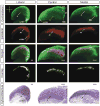
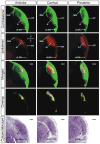

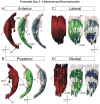
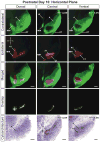
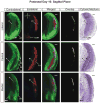
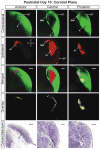

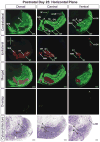
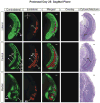

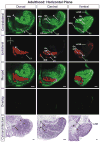
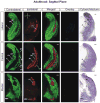
Similar articles
-
Necessity for afferent activity to maintain eye-specific segregation in ferret lateral geniculate nucleus.Science. 2000 Mar 31;287(5462):2479-82. doi: 10.1126/science.287.5462.2479. Science. 2000. PMID: 10741966 Free PMC article.
-
Pattern formation by retinal afferents in the ferret lateral geniculate nucleus: developmental segregation and the role of N-methyl-D-aspartate receptors.J Comp Neurol. 1999 Aug 23;411(2):327-45. doi: 10.1002/(sici)1096-9861(19990823)411:2<327::aid-cne12>3.0.co;2-#. J Comp Neurol. 1999. PMID: 10404257
-
Prenatal development of retinogeniculate projections in the rabbit: an HRP study.J Comp Neurol. 1990 Sep 1;299(1):75-88. doi: 10.1002/cne.902990106. J Comp Neurol. 1990. PMID: 2212112
-
'Hidden lamination' in the dorsal lateral geniculate nucleus: the functional organization of this thalamic region in the rat.Brain Res. 1988 Apr-Jun;472(2):119-37. doi: 10.1016/0165-0173(88)90017-3. Brain Res. 1988. PMID: 3289687 Review.
-
Development of On and Off retinal pathways and retinogeniculate projections.Prog Retin Eye Res. 2004 Jan;23(1):31-51. doi: 10.1016/j.preteyeres.2003.10.001. Prog Retin Eye Res. 2004. PMID: 14766316 Review.
Cited by
-
Epibatidine blocks eye-specific segregation in ferret dorsal lateral geniculate nucleus during stage III retinal waves.PLoS One. 2015 Mar 20;10(3):e0118783. doi: 10.1371/journal.pone.0118783. eCollection 2015. PLoS One. 2015. PMID: 25794280 Free PMC article.
-
Activity-dependent disruption of intersublaminar spaces and ABAKAN expression does not impact functional on and off organization in the ferret retinogeniculate system.Neural Dev. 2011 Mar 14;6:7. doi: 10.1186/1749-8104-6-7. Neural Dev. 2011. PMID: 21401945 Free PMC article.
-
Early Postnatal Development of the Lamination in the Lateral Geniculate Nucleus A-Layers in Cats.Cell Mol Neurobiol. 2018 Jul;38(5):1137-1143. doi: 10.1007/s10571-018-0585-6. Epub 2018 Apr 17. Cell Mol Neurobiol. 2018. PMID: 29666956 Free PMC article.
-
A theory of cortical map formation in the visual brain.Nat Commun. 2022 Apr 28;13(1):2303. doi: 10.1038/s41467-022-29433-y. Nat Commun. 2022. PMID: 35484133 Free PMC article.
-
Postnatal development of chorda tympani axons in the rat nucleus of the solitary tract.J Comp Neurol. 2012 Oct 1;520(14):3217-35. doi: 10.1002/cne.23093. J Comp Neurol. 2012. PMID: 22430892 Free PMC article.
References
-
- Akerman CJ, Smyth D, Thompson ID. Visual experience before eye-opening and the development of the retinogeniculate pathway. Neuron. 2002;36:869–879. - PubMed
-
- Akerman CJ, Tolhurst DJ, Morgan JE, Baker GE, Thompson ID. Relay of visual information to the lateral geniculate nucleus and the visual cortex in albino ferrets. J Comp Neurol. 2003;461:217–235. - PubMed
-
- Angelucci A, Clasca F, Sur M. Anterograde axonal tracing with the subunit B of cholera toxin: a highly sensitive immunohistochemical protocol for revealing fine axonal morphology in adult and neonatal brains. J Neurosci Methods. 1996;65:101–112. - PubMed
-
- Bjartmar L, Huberman AD, Ullian EM, Renteria RC, Liu X, Xu W, Prezioso J, Susman MW, Stellwagen D, Stokes CC, Cho R, Worley P, Malenka RC, Ball S, Peachey NS, Copenhagen D, Chapman B, Nakamoto M, Barres BA, Perin MS. Neuronal pentraxins mediate synaptic refinement in the developing visual system. J Neurosci. 2006;26:6269–6281. - PMC - PubMed
Publication types
MeSH terms
Grants and funding
LinkOut - more resources
Full Text Sources
Medical

